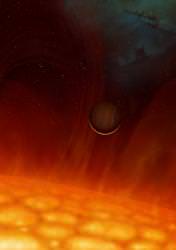When a star like our own Sun nears the end of its 10 billion year life, it expands up into a red giant, consuming any planets foolish enough to orbit closely. But what happens to the more distant planets? Astronomers have discovered just such a planet, orbiting a red giant star. Perhaps this gives us hope for the fate of our own planet Earth, when the Sun expands too. Not so fast.
An international team of astronomers from 15 different countries announced the planetary discovery, and their article will be published in the September 13th edition of the journal Nature.
The planet is called V 391 Pegasi b, and before its parent star transformed into the red giant we see today, it orbited at roughly the same distance as the Earth. As the star expanded, its centre of gravity changed, and the planet’s orbit spiraled outward, keeping pace with the changing star. Although the star now engulfs a distance comparable between the Sun and the Earth, the planet is now out past the orbit of Mars; takes 3.2 years to complete a full year.
So does this mean the Earth’s safe? Not so fast. Here’s one of the researchers, Steve Kawaler from Iowa State University:
“We shouldn’t take too much heart in this – this planet is larger than Jupiter, so a smaller planet like the Earth could still be vulnerable. As far as our planets are concerned, we expect Mercury and Venus to disappear in the Sun’s envelope, whereas Mars should survive. The fate of the Earth is less clear because its position is really at the limit: it appears more likely that the Earth will not survive the red giant expansion of the sun either, but it is not for sure.”
Finding this planet was incredibly laborious work. It took seven years of observations and calculations to confirm its existence. It also marks the first time that a new technique was used to discover planets. Traditionally, astronomers measure the change in a planet’s velocity as it’s yanked back and forth by the gravity of a large planet using a technique called spectroscopy, where the spectrum of its light shifts. In the case of V391 Pegasus b, the astronomers measured small variations in timing of light coming from the star to determine its velocity.
Original Source: University of Delaware News Release


tnx to God bec. of him our life is so cool amazing wonderfuel
It’s all just an edu-ma-cated gue-stimate at this point. This article was poorly written. No information much at all. What class of star is it?, How far away is it?, Where is it located at in the night sky? What have they learned about Pegasus b? What size telescope/s was used? I know this post may read bad, but Cain should remember that when he writes about something, that every sentence should answer the basic 6 questions of, Who/m, what, when, where, why, and how. I realize no one is perfect, but I just thought I would toss that in to help out this cain guy for any future articles he may write.